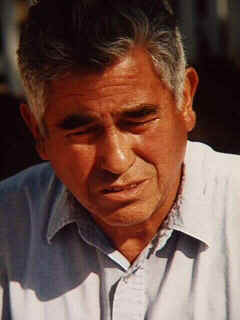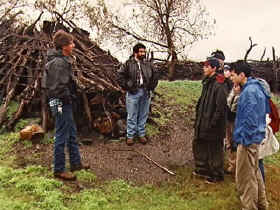|
| |
The Ohlone Through the Years

In Search of an Accurate History
By: Cecilia Barrenechea

 Only two hundred years ago, the land that I live in and call California was
a very different place. Before the coming of European colonists the many Indian Nations of
the Monterey Bay area, known as Costenos (Costanoans) or Ohlone Indians, lived in a rich,
native environment amongst diverse animal and plant populations. Today there numbers are
small. The coming of Spanish missions brought on a sad period to this people’s
history. Forced into missions and forbidden to maintain their culture and beliefs, they
were removed from their lands and isolated from their culture and people. Felipe Galvan
(he prefers to be called Phil), a seventy-four year old Ohlone descendent who works at
Mission San Jose in the East Bay, tells us that even within the mission the men and women
were segregated at all times and it was very hard to get a group together for a ceremony.
Ceremonies were forbidden and anyone caught in the act were severally punished. Not only
had they lost their heritage but also ineligible for tribal status as outlined by the
Bureau of Indian Affairs. The State and federal government are not bound to uphold
treaties made with the Ohlone concerning land and water rights, as well as other
privileges given to other federally recognized tribes. The struggle continues to keep
alive a culture that nearly became extinct. Only two hundred years ago, the land that I live in and call California was
a very different place. Before the coming of European colonists the many Indian Nations of
the Monterey Bay area, known as Costenos (Costanoans) or Ohlone Indians, lived in a rich,
native environment amongst diverse animal and plant populations. Today there numbers are
small. The coming of Spanish missions brought on a sad period to this people’s
history. Forced into missions and forbidden to maintain their culture and beliefs, they
were removed from their lands and isolated from their culture and people. Felipe Galvan
(he prefers to be called Phil), a seventy-four year old Ohlone descendent who works at
Mission San Jose in the East Bay, tells us that even within the mission the men and women
were segregated at all times and it was very hard to get a group together for a ceremony.
Ceremonies were forbidden and anyone caught in the act were severally punished. Not only
had they lost their heritage but also ineligible for tribal status as outlined by the
Bureau of Indian Affairs. The State and federal government are not bound to uphold
treaties made with the Ohlone concerning land and water rights, as well as other
privileges given to other federally recognized tribes. The struggle continues to keep
alive a culture that nearly became extinct.
Going back to a time before the European explorers, the area itself would not be
recognizable by today’s inhabitants. The area had an abundance of nutritious plants
which are now extinct. The Ohlone’s diet included many different kinds of foods from
these nutritious plant sources. Grasses, roots, seeds, and especially acorns were an
important part of the diverse range of foods eaten. Felipe remembers growing up, the
different foods his mother would serve him and his brothers and sisters. These were foods
not very common to other children, such as poison oak. This may seem as severe treatment
but in actuality it was nutritious and not at all harmful when eaten at certain times of
the year. "We would ask my mother what it was and she would tell us to just eat it.
After we had eaten it she would tell us it was poison oak and that she didn’t tell us
before because then we wouldn’t eat it," Felipe recalls. By doing this his
mother would show Felipe and his siblings that, "You can eat anything native to the
land at the right time." Other native foods Felipe remembers include green beans,
soap plant, cucumbers, acorns, estafiata (similar to rosemary), and figs.
 Along with
abundant plant life was a great animal population. The land was crawling with all types of
animals, from tiny insects to the grizzly bear which we no longer see. The Ohlone ate them
all: insects, reptiles, rodents, birds, fish, and larger game animals of all kinds. Foods
that aren’t as popular to today’s modern plate, such as grasshoppers and yellow
jacket grubs, were enjoyable additions to the native diet. Other stories tell of wildlife
so unafraid that one shot commonly killed three birds, and rabbits could sometimes be
caught with your bare hands as they ran by. Animals that in modern times are very shy and
reclusive, such as the sea otter, the gray fox, and the grizzly bear, were under foot and
frequently a nuisance. The deer were so familiar with man that early explorers could ride
their horses right up into the herd without disturbance. Along with
abundant plant life was a great animal population. The land was crawling with all types of
animals, from tiny insects to the grizzly bear which we no longer see. The Ohlone ate them
all: insects, reptiles, rodents, birds, fish, and larger game animals of all kinds. Foods
that aren’t as popular to today’s modern plate, such as grasshoppers and yellow
jacket grubs, were enjoyable additions to the native diet. Other stories tell of wildlife
so unafraid that one shot commonly killed three birds, and rabbits could sometimes be
caught with your bare hands as they ran by. Animals that in modern times are very shy and
reclusive, such as the sea otter, the gray fox, and the grizzly bear, were under foot and
frequently a nuisance. The deer were so familiar with man that early explorers could ride
their horses right up into the herd without disturbance.
Contrary to unkind and inaccurate accounts of Native Americans, the Ohlone were an
intelligent group of people who made full use of the abundant resources available to them.
Very little in their surrounding environment went to waste. They made snares, decoys, and
other weapons for hunting, and devised advanced methods of preparing all types of acorns
that leached away the bitterness which they could then make into flour, bread, mush, and
soup. The gathering and preparing of the food was a social and religious aspect of the
Ohlone’s daily lives. The gathering and processing of plants and acorns was done by
the women and the hunting by the men. Food preparation served an important role in the
religious and social cohesion of the tribe.

The Ohlone moved frequently to different locations through out the year in order to
make the most of their territory. Having visited Ohlone land in the East Bay, one can see
the movements of the people over time. One can see where the land gets higher and there
are shell mounds covered by more land in different places evening out the land on which
others had previously lived on. The Ohlone would live in one area for a period of time, as
they used up the resources around them and made their own mounds of shells, they would
move on to other grounds. The land would later replenish itself and a new group of people
would move to the area, make their mounds, and leave as the previous people had. Thus the
cycle continues.
The hunt for the men was very ceremonial. They went through intense physical and
spiritual preparation to correct behavior from beginning to end. The spirit was prepared
with songs and dances; the body with strict dietary provisions and by abstaining from
sexual activity; and the mind through meditations and just hanging out in the sweat lodge.
The men followed these steps and developed stronger bonds amongst themselves and their
spiritual world. When visiting the 2,000 year old Ohlone shell mounds, we saw a replica of
an Ohlone village and within it a sweat lodge. Being there I did something that would have
been very prohibited in the tribe, entering the sweat lodge. This structure was strictly
for the men and women were not to enter.
Felipe tells us about the time when there was an eclipse and the sisters who lived
near by asked him if he had seen it. He answered that he had not and explained to them the
Ohlone belief. When there is an eclipse there is a doorway taking those who have died to
the great beyond. The person who has died is able to go through the passage way as well as
take others with them. If a relative of the person who died were to look at the eclipse
the spell would be broken and the doorway to the greater beyond would be closed. He then
chuckles and says, he didn’t want to be responsible for any one not being let in to
the great beyond. Another belief is that after a baby is born it is taken to face the East
similar to how a baby is presented to a church. Also the baby is not to be scratched
directly by the mother but with a sort of comb made of bone. As we go on I ask Felipe how
he deals with religion, what does he believe. He tells me that it isn’t just one way
or the other, the beliefs are mixed. His family has been brought up Catholic but still
holds Ohlone traditions and spirituality. Felipe explains that the Ohlone religion has to
do more with nature and goes on to tell a story about how Earth was created. This story is
told in ceremonies along with a ceremonial dance. I am telling this story to the best of
my memory and notes keeping as much of the story just as Felipe told us.

 The Great
Spirit The Great
Spirit
One day the Great Spirit saw a blue tiny dot far away. He decided that when he had
some time he would go check it out. So one day the Great Spirit took the form of an eagle
and flew towards the tiny blue dot. As he flew there were many meteors and he was hit but
went on. Once he Great Spirit was close enough to the blue dot he plucked a feather and
let it go. The feather went down and hit the blue, it was water. The feather started
spinning around and created a whirlpool. It spun and spun until it stopped forming crust
and that’s how Earth was formed. The Great Spirit than created trees, animals, life.
The Great Spirit than realized that he had not given them a form of communication so he
called all the animals in and gave each of them a manner of speech. The coyote and dove
got there late, the Great Spirit said it was too bad and that he could not punish them but
that he would not let them forget this day. So he told coyote that he would never die, he
would always be around and gave dove the morning cry. So now the coyote is still around
and the dove is heard doing its morning call which sounds like a cry, and that is how that
day will never be forgotten.

Web page construction assistance by Alana Salom of The Learning
Community
|